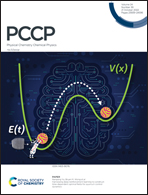Charge transfer and electrical double layer of an amphiphilic protic ionic liquid in bulk and when confined in nanochannels†
Abstract
We report the behavior of the protic and surface active ionic liquid octylimidazolium bis(trifluoromethylsulfonyl)imide, [HC8Im][TFSI], in bulk and inside silica nanochannels, at the interface with the conductive substrate indium tin oxide (ITO) upon applied potential. The two distinct cases of the ionic liquid being in contact with a bare ITO substrate and an ITO substrate covered with a thin film of mesoporous silica containing vertically-aligned channel-like pores have been investigated. These correspond to the behavior of the bulk ionic liquid and the ionic liquid confined within nanochannels (approximately 3.5 nm wide and 65 nm long). Broadband dielectric spectroscopy (BDS) and electrochemical impedance spectroscopy (EIS) have been used as the experimental methods, while modelling with equivalent circuits has been applied to evaluate the experimental results. Thus, this study does not only show a functional ionic liquid/silica hybrid material, but also presents an in-depth electrochemical characterization revealing an enhanced specific capacitance at the confined-IL/ITO interface (∼16 μF cm−2) as compared to the case of bulk IL/ITO (∼6 μF cm−2). This suggests that local structure and ion ordering inside the nanochannels of silica are different from that of the bulk ionic liquid, favoring denser ionic packing and a higher specific capacitance at the metal interface.



 Please wait while we load your content...
Please wait while we load your content...